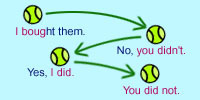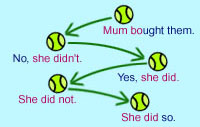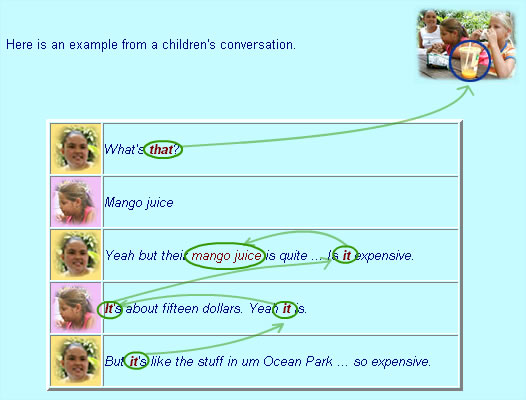Text types: Texts for social interaction
| Overview |
Linking turns to create texts for social interaction
Each person taking part in a social interaction takes turns to speak and as the turns unfold one after the other, a text for social interaction is constructed. The turns are linked in a sequence, ie one turn follows another, but there are also other kinds of links between the turns in an interaction, including the following:
| links of expectation | |
| grammar links | |
| links made by vocabulary, pronouns and connectives |
In spoken interactions speakers also manage information across turns in order to maintain or shift topics, or to focus on different aspects of the topic.
Links of expectation
Whenever we initiate a turn in an interaction, we usually expect a certain kind of response:
| When we make a statement, we expect other speakers to support or contradict us. | |
| When we ask a question, we expect another speaker to answer. | |
| When we offer speakers something, we expect them to accept or refuse our offer. | |
| When we command or request someone to do something for us, we expect some action, or perhaps a refusal. |
These expectations create string links between Initiations and Responses. The link is so strong that an expected Response often leaves out most of the words used in the Initiation because these words can be assumed.
| Initiation | Expected response | ||
| Question | Did you call me? | Yes [I did call you] | Answer |
| Offer | Do you want to come and play tomorrow? | Yes please [I do want to come and play ...] | Acceptance |
Grammar links
| Clauses in English have special grammatical structures which make it possible for people to interact with each other. These structures are most visible when children are having an argument. The pattern of structures in a child's argument can be visualised like the pattern of action in a tennis match, where one player hits a ball over the net and the other tries to hit the ball back. |  |
Here is a short, imaginary interaction between two children having an argument about crisps:
|
||
The first speaker initiates the interaction with a complete clause in two parts, they're and my crisps. The following turns are shortened clauses in which the pronoun they and the verb are are hit back and forth to keep the argument going. The other part (my crisps), ie what the argument is about, disappears once the argument starts. Sometimes they and are are contracted (they're), and sometimes not (they are), depending on the words the speaker wants to stress. The second speaker adds the negative word not to the Subject-Finite 'ball' to show she does not agree with the first speaker's statement. Note the contraction they're not, used in place of they aren't, to emphasise the negative word not. |
If the first speaker initiates a new Subject, the centre of the argument changes, and the topic or 'ball' which is hit back and forth also changes:
 |
The first speaker
uses a full clause to initiate a new turn with a new Subject. Again this
clause has two parts I bought and them. The following turns are shortened clauses. When the second speaker
responds, the Subject is the pronoun you. The Subject, I/you,
and the singular past simple substitute verb did is hit back and
forth to keep the argument going.
Once again the other part of the initiating clause (them), ie the crisps they are arguing over, disappears once this part of the argument starts. |
Here the second speaker initiates a new Subject in order to change the centre of the argument:
 |
The second speaker
uses a full clause to initiate a new turn with a new Subject. Again this
clause has two parts, Mum bought and them.
The following turns are shortened clauses. When the initial first speaker
responds, the Subject is the pronoun she. In these clauses the
Subject she and the singular past simple substitute verb did is hit back and
forth to keep the argument going. As above, the other part of the
initiating clause (them, ie the crisps)
disappears once this part of the argument starts.
In the last turn the second speaker uses the substitute word so to replace and emphasise the missing part of the initial clause, ie bought them. |
These types of interactions illustrate how the
Subject-Finite 'ball' is used to keep an interaction going. In real life
interactions there are often many interruptions and rapid changes of
Subject so that this pattern is not so visible. The Subject-Finite 'ball', however, is one of the strongest links between
turns in an interaction. ![]()
The link of expectation combined with the grammatical link made by hitting back the same Subject-Finite 'ball' are very strong. If speakers want to break these links by saying something unexpected or changing the Subject, they usually signal this to the other speakers very explicitly at the beginning of their turn by using expressions such as, By the way, Oh I just remembered, You know:
You know, in Ocean Park, when I went with my friend Emma ...
In the example below, the first child hits the Subject-Finite 'ball' with a tag question at the end of her turn. The second child doesn't use the same Subject-Finite 'ball', but instead uses a complete clause to introduce a new Subject-Finite 'ball', 'they don't'. In her next turn, the first child hits back the new 'ball' using a shortened clause:
Vocabulary links
Speakers link the turns in an interaction by repeating
vocabulary, ie using repetition, and by using words which we can predict will be used to talk about
the topic, ie collocation. ![]()
In this example several words are collocations of shopping, ie vocabulary we can predict will be used when we are shopping:
How much is this? Let me check the price. Yes eighteen dollars.
Can I buy this please?
Pronoun links
In spoken interactions speakers use pronouns and possessive adjectives to refer to:
Pronoun chains can cross over from one turn to the next and help to link the turns to each other and to the outside context:

Substitute words and general nouns are also used to refer to
people and things both inside the interaction and outside but in the context. In spoken interactions speakers often use
substitute
words, instead of the actual words, to refer to things in the immediate
context shared by the speakers, eg one, ones. Substitute words often work
with pronouns to keep track of a topic across turns. Substitute words are often used with gestures and facial expressions which
can provide important clues to understanding during
spoken interaction. Learning the gestures and facial expressions used by English
speakers is part of learning how to speak English.
![]()
![]()
In spoken interactions the substitute word one is often used to
clarify after an echo question. ![]()
In spoken interactions the Subject of a clause is often a pronoun. Sometimes in spoken interaction, after a speaker introduces a long Subject, the speaker will then use a pronoun to summarise it:

In informal spoken interactions speakers often use general nouns as
substitute words, eg thing, stuff. ![]()
Connective links
In spoken interactions connectives are used to link meanings across the turns of the interaction. The most common connections do the following work:
| Show that a turn continues from the previous turn (yeah, well, so, OK). | |
| Add meanings (and, also). | |
| Contrast meanings (but). | |
| Connect meanings in time (when, then, whenever). | |
| Connect meanings to cause, consequence or
condition (so, in order to, because, if).
|
| To see how connectives are used to link meanings across turns in a conversation, click here: |  |
Managing information across turns
In spoken interactions the beginning of a turn, or Theme, manages the information in the following ways:
In spoken interactions the end of a turn is usually used to emphasise
new information which the speaker wants people listening to pay attention to.
Usually the speaker stresses this information. ![]()
|
||
To give us feedback about this section, click here or on the Comment button at the top of the screen.
If you have any questions about this section, visit the Language Corner.
If you have any questions or suggestions about how to teach this section, send a message to the Teaching Corner.